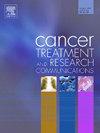Epidemiological description of genetic alterations and prognosis in Mexican patients with melanoma: a retrospective cohort
IF 2.4
Q3 Medicine
引用次数: 0
Abstract
Background
Melanoma is currently the most aggressive skin cancer. It is currently categorized based on mutations that have been studied for their prognostic relevance.
Objective
Define the epidemiology of mutations in patients with melanoma in Mexico using the Next-Generation Sequencing technology and explore its prognosis utility in terms of prognosis.
Methods
A descriptive, multicentric, analytical, and retrospective study was conducted on sixteen patients with melanoma and NGS.
Results
Sixteen patients with nodular, lentiginous acral melanoma, and superficial extension were included. We found sixteen different mutations in the melanoma samples. The most frequent mutation in our population was the BRAF mutation (56.3 %); the CCND1 and NRAS mutations were found in 18.8 %. There was a statistically significant association between NRAS and mortality. Median progression-free survival was 27 months (95 % CI = 6.5–47.42 months) and median overall survival was 40.18 months (95 % CI = 19.03 – 61.3 months). The frequency of the mutations we found is similar to the ones reported in the literature, except for CD274, ROS1, and CDKN2A/B, which are more common in our population. We only found a prognostic value with NRAS, even though there is some evidence of mortality associated with other mutations.
Conclusion
NGS is a useful tool that can detect multiple mutations in the same patient. Detecting profiles with prognostic values and mutations for targeted therapy is an option for these patients, however, the usefulness of these results must be further studied in larger cohorts.
墨西哥黑色素瘤患者遗传改变和预后的流行病学描述:回顾性队列
黑色素瘤是目前最具侵袭性的皮肤癌。目前,它是根据研究其预后相关性的突变进行分类的。目的利用新一代测序技术确定墨西哥黑色素瘤患者突变的流行病学,并探讨其在预后方面的应用价值。方法对16例黑色素瘤合并NGS患者进行描述性、多中心、分析性和回顾性研究。结果16例结节性、晶状体性肢端黑色素瘤伴浅表延伸。我们在黑色素瘤样本中发现了16种不同的突变。我们人群中最常见的突变是BRAF突变(56.3%);CCND1和NRAS突变占18.8%。NRAS与死亡率之间存在统计学上的显著关联。中位无进展生存期为27个月(95% CI = 6.5-47.42个月),中位总生存期为40.18个月(95% CI = 19.03 - 61.3个月)。我们发现的突变频率与文献报道的相似,除了CD274, ROS1和CDKN2A/B,它们在我们的人群中更常见。我们只发现了NRAS的预后价值,尽管有一些证据表明死亡率与其他突变有关。结论ngs是检测同一患者多基因突变的有效工具。检测具有预后价值和靶向治疗突变的特征是这些患者的一种选择,然而,这些结果的有效性必须在更大的队列中进一步研究。
本文章由计算机程序翻译,如有差异,请以英文原文为准。
求助全文
约1分钟内获得全文
求助全文
来源期刊

Cancer treatment and research communications
Medicine-Oncology
CiteScore
4.30
自引率
0.00%
发文量
148
审稿时长
56 days
期刊介绍:
Cancer Treatment and Research Communications is an international peer-reviewed publication dedicated to providing comprehensive basic, translational, and clinical oncology research. The journal is devoted to articles on detection, diagnosis, prevention, policy, and treatment of cancer and provides a global forum for the nurturing and development of future generations of oncology scientists. Cancer Treatment and Research Communications publishes comprehensive reviews and original studies describing various aspects of basic through clinical research of all tumor types. The journal also accepts clinical studies in oncology, with an emphasis on prospective early phase clinical trials. Specific areas of interest include basic, translational, and clinical research and mechanistic approaches; cancer biology; molecular carcinogenesis; genetics and genomics; stem cell and developmental biology; immunology; molecular and cellular oncology; systems biology; drug sensitivity and resistance; gene and antisense therapy; pathology, markers, and prognostic indicators; chemoprevention strategies; multimodality therapy; cancer policy; and integration of various approaches. Our mission is to be the premier source of relevant information through promoting excellence in research and facilitating the timely translation of that science to health care and clinical practice.
 求助内容:
求助内容: 应助结果提醒方式:
应助结果提醒方式:


